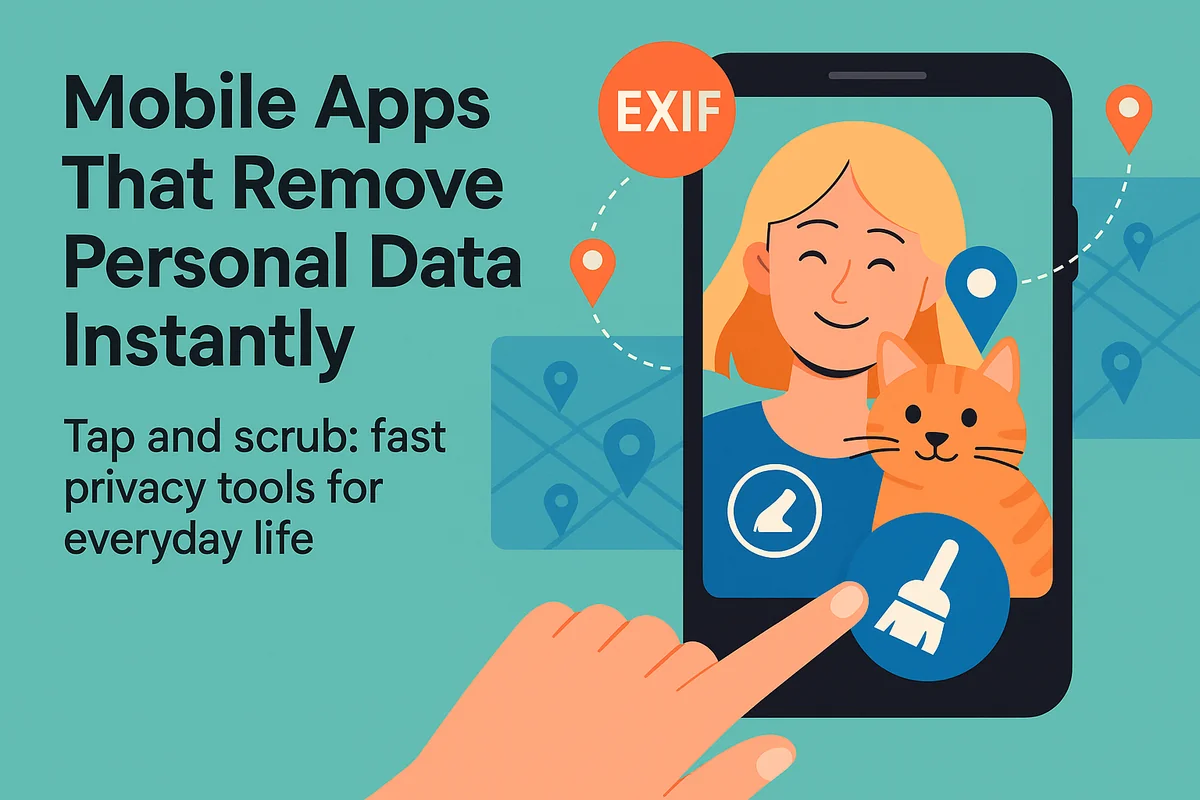Mobile Apps That Remove Personal Data Instantly
Tap and scrub: fast privacy tools for everyday life.
Ever posted a pet photo, only to realize it tagged your street? You’re not alone.
In 2022, people took 4.7 billion photos every day, and over 3.2 billion went online — many with hidden location data.
That invisible photo metadata—often EXIF metadata—can store the time, camera details, and exact GPS coordinates. In the wrong hands, that's like giving a stranger your front door key.

Why Your Next Selfie Might Give Away Your Address
Photo metadata is more revealing than most people realize. Every time you snap a picture with your smartphone, it automatically embeds information that goes far beyond the visible image. This hidden data can include your exact location, the time you took the photo, and details about your device.
The scale of this issue is staggering. With billions of photos uploaded daily to social media platforms, Instagram, Facebook, and other services, millions of people unknowingly share their private information through photo metadata.
What's Really Inside Your Photos?
Metadata isn't just boring camera settings. It can hold:
- GPS coordinates from geotagging
- Camera brand and model
- Date and time of capture
- Exposure, ISO, and other technical info
- Software used to edit the photo
- Copyright information
- User comments and descriptions
In a study of 100,000 images, 10 % of new photos contained GPS tags.
Even after resharing, 1 % still did.(SpringerLink – Unique in the Crowd: The privacy bounds of human mobility)
Sometimes that's useful—for photographers who need to organize their work or prove when and where a photo was taken. But for the rest of us, it's a metadata risk we don't need.
The Day Metadata Caught a Man
Real-world consequences of metadata exposure can be serious. When John McAfee’s photo hit the internet in 2012, embedded GPS data revealed his hideout.
One click, and the world knew where he was.(WIRED – How Metadata Exposed John McAfee)
A journalist faced similar trouble — sharing a single image led to threats and relocation.(Comparitech – Real Metadata Privacy Incidents) These aren't isolated incidents. Privacy breaches through photo metadata happen more often than you might think.
Not exactly the "likes" they were hoping for.
Why You Shouldn't Rely on Social Platforms
Instagram and Facebook remove some GPS info, but often keep camera data.(ExifViewer Guide – What Metadata Social Media Really Strips)
Better to clean it yourself with an EXIF cleaner or a browser-based tool before posting. Think of it as washing your hands before dinner—you don't leave it to the waiter.
Social media platforms have their own reasons for keeping certain metadata:
- Content organization and search functionality
- Advertising targeting based on device and location patterns
- Analytics for platform improvement
- Legal compliance requirements
Quick Guide: How to Remove Personal Data from Photos
The 5-Step Process:
- Check for hidden info – Use a metadata viewer to see what's inside your photos
- Pick your cleaner – Your phone's built-in feature, DropTidy, or another metadata remover
- Wipe GPS and camera data – Remove your digital fingerprint
- Double-check – Confirm the data is gone with a verification tool
- Post without worry – Enjoy secure photo sharing
Mobile-Specific Tips:
- iPhone users: Use the "Remove Location Info" option when sharing
- Android users: Check your camera settings for location tagging
- Cross-platform: Use browser-based tools like DropTidy for consistent results
My Wake-Up Call
I once shared a sunset photo from a "secret" beach. A friend messaged: "Nice spot. Google Maps says it's 3 km south of town." My GPS tag had given it away.
Since then, I always run photos through a browser-based scrubber. No installs, no tracking—just instant cleanup. It takes seconds and gives me peace of mind.
The experience taught me that privacy isn't just about what you choose to share—it's about understanding what you're sharing without realizing it.
Mobile Apps vs. Browser Tools: What's Better?
Mobile Apps:
- Pros: Integrated with your photo workflow, offline capability
- Cons: Need to download and trust another app, may have limited features
Browser Tools (like DropTidy):
- Pros: No installation required, works on any device, more secure (processing happens locally)
- Cons: Requires internet connection, extra step in your workflow
For most users, browser-based tools offer the best balance of security, convenience, and functionality.
The Future of Photo Privacy
As awareness grows, we're seeing more built-in privacy features:
- Apple now prompts users before sharing location data
- Google Photos offers automatic metadata removal options
- Camera manufacturers are adding privacy-focused shooting modes
But until these features become universal and default, manual metadata removal remains your best protection.
Stay in Control of Your Photos
Every image leaves a trail. Make sure it's one you're happy to share.
Try DropTidy now – clean photo metadata instantly, right in your browser.
Click to clean in seconds.
Share the photo, not the location.
Key Takeaways
- 4.7 billion photos are taken daily, with over 3 billion shared online
- 10% of photos still contain GPS data even after sharing
- Social platforms don't remove all metadata consistently
- Browser-based tools offer the most secure metadata removal
- Manual verification is important even after cleaning
FAQ
Q: Do all photos contain metadata?
A: Most digital photos contain some metadata, but the amount varies by device and settings.
Q: Is it safe to use online metadata removal tools?
A: Tools like DropTidy process photos locally in your browser, so your images never leave your device.
Q: Can I remove metadata permanently?
A: Yes, once properly removed, metadata cannot be recovered from the cleaned image file.
Q: Should I always remove metadata?
A: For casual sharing, yes. For professional or legal documentation, consider keeping original copies with metadata intact.